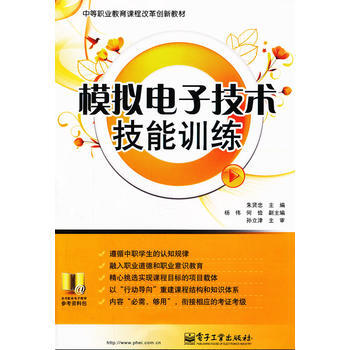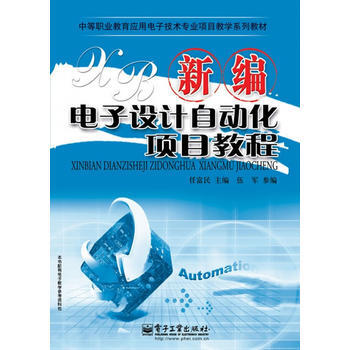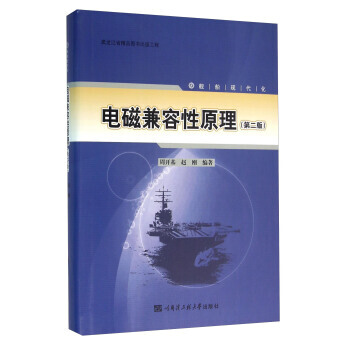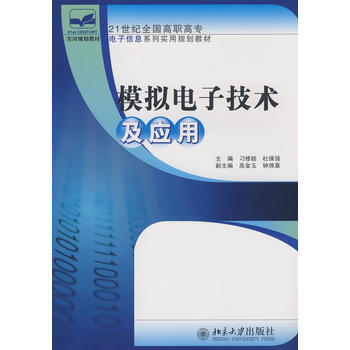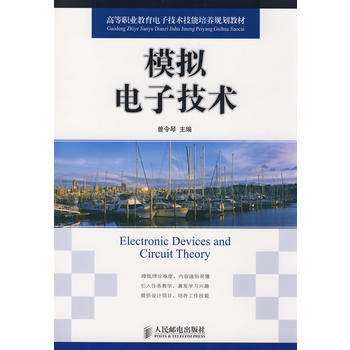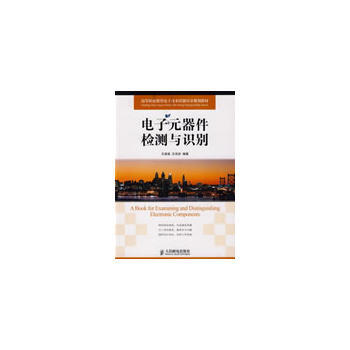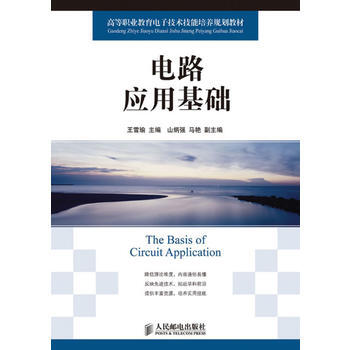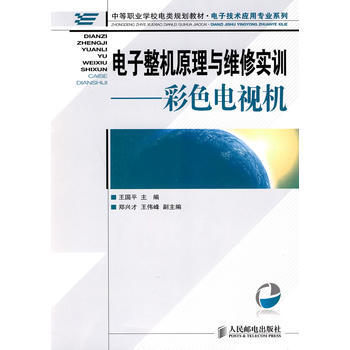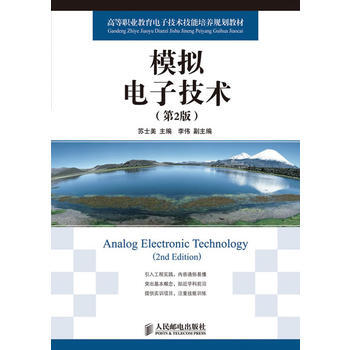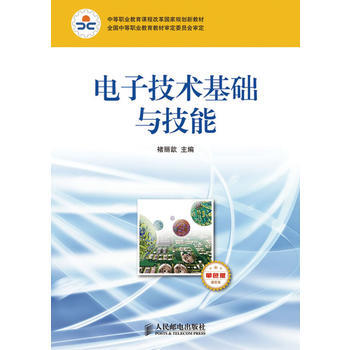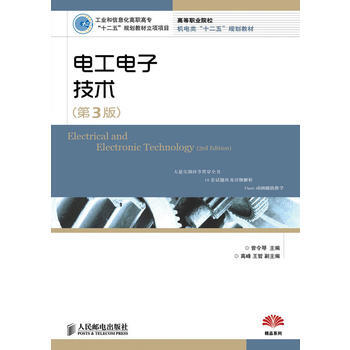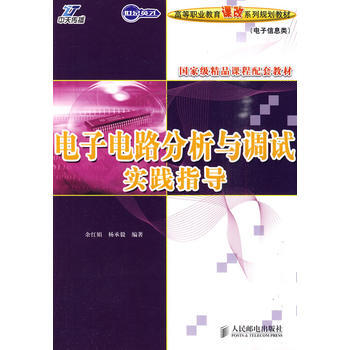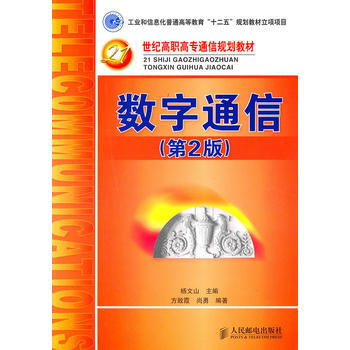

具体描述
基本信息
书名:数字信号处理(英文版)
定价:39.80元
作者:蔡坤宝著
出版社:电子工业出版社
出版日期:2007-08-01
ISBN:9787121047633
字数:999600
页码:392
版次:1
装帧:平装
开本:
商品重量:0.640kg
编辑推荐
内容提要
本书系统地阐述了数字信号处理所涉及的信号与系统分析和系统设计的基本理论、基本分析与设计方法、基本算法和处理技术。全书共10章,主要内容包括:离散时间信号与系统的基本概念,离散时间信号与系统的变换域分析,包括z变换和离散时间傅里叶变换、连续时间信号的抽样与重建,离散傅里叶变换及其快速算法(FFT),数字滤波器实现的基本结构,IIR和FIR 数字滤波器的设计原理与基本设计方法,数字信号处理中的有限字长效应,多抽样率数字信号处理。本书配有多媒体电子课件、英文版教学大纲、习题指导与实验手册。
本书可以作为电子与通信相关专业的本科数字信号处理课程中英文双语教学的教材,或中文授课的英文版教学参考书,也可供从事数字信号处理的工程技术人员学习参考。本书尤其适合初步开展数字信号处理课程中英文双语授课的教师与学生选用。
目录
1 Introduction
1.1 What Is a Signal
1.2 What Is a System
1.3 What Is Signal Processing
1.4 Classification of Signals
1.4.1 Deterministic and Random Signals
1.4.2 Continuous-Time and Discrete-Time Signals
1.4.3 Periodic Signals and Nonperiodic Signals
1.4.4 Energy Signals and Power Signals
1.5 Overview of Digital Signal Processing
2 Discrete-Time Signals and Systems
2.1 Discrete-Time Signals: Sequences
2.1.1 Operation on Sequences
2.2 Basic Sequences
2.2.1 Some Basic Sequences
2.2.2 Periodicity of Sequences
2.2.3 Representation of Arbitrary Sequences
2.3 Discrete-Time systems
2.3.1 Classification of Discrete-Time systems
2.4 Time-Domain Representations of LTI Systems
2.4.1 The Linear Convolution Sum
2.4.2 Interconnections of LTI Systems
2.4.3 Stability Condition of LTI systems
2.4.4 Causality Condition of LTI systems
2.4.5 Causal and Anticausal Sequences
2.5 Linear Constant-Coefficient Difference Equations
2.5.1 Recursive Solution of Difference Equations
2.5.2 Classical Solution of Difference Equations
2.5.3 Zero-Input Response and Zero-State Response
2.5.4 The Impulse Response of Causal LTI Systems
2.5.5 Recursive Solution of Impulse Responses
2.5.6 Classification of LTI Discrete-Time Systems
Problems
3 Transform-Domain Analysis of Discrete-Time Signals and Systems
3.1 The z-Transform
3.1.1 Definition of the z-Transform
3.1.2 A General Shape of the Region of Convergence
3.1.3 Uniqueness of the z-Transform
3.2 Relation Between the ROCs and Sequence Types
3.3 The z-Transform of Basic Sequences
3.4 The Inverse z-Transform
3.4.1 Contour Integral Method
3.4.2 Partial Fraction Expansion Method
3.4.3 Long Division Method
3.4.4 Power Series Expansion Method
3.5 Properties of the z-Transform
3.6 The Discrete-Time Fourier Transform
3.6.1 Definition of the Discrete-Time Fourier Transform
3.6.2 Convergence Criteria
3.6.3 Properties of the Discrete-Time Fourier Transform
3.6.4 Symmetry Properties of the Discrete-Time Fourier Transform
3.7 Transform-Domain Analysis of LTI Discrete-Time Systems
3.7.1 The Frequency Response of Systems
3.7.2 The Transfer Function of LTI Systems
3.7.3 Geometric Evaluation of the Frequency Response
3.8 Sampling of Continuous-Time Signals
3.8.1 Periodic Sampling
3.8.2 Reconstruction of Bandlimited Signals
3.9 Relations of the z-Transform to the Laplace Transform
Problems
4 The Discrete Fourier,Transform
4.1 The Discrete Fourier Series
4.2 Properties of the Discrete Fourier Series
4.2.1 Evaluation of the Periodic Convolution Sum
4.3 The Discrete Fourier Transform
4.4 Properties of the Discrete Fourier Transform
4.4.1 Circular Convolution Theorems
4.5 Linear Convolutions Evaluated by the Circular Convolution
4.6 Linear Time-Invariant Systems Implemented by the DFT
4.7 Sampling and Reconstruction in the z-Domain
4.8 Fourier Analysis of Continuous-Time Signals Using the DFT
4.8.1 Fourier Analysis of Nonperiodic Continuous-Time Signals
4.8.2 Practical Considerations
4.8.3 Spectral Analysis of Sinusoidal Signals
Problems
5 Fast Fourier Transform Algorithms
5.1 Direct Computation and Efficiency Improvement of the DFT
5.2 Decimation-in-Time FFT Algorithm with Radix-2
5.2.1 Butterfly-Branch Transmittance of the Decimation-in-Time FFT
5.2.2 In-Place Computations
5.3 Decimation-in-Frequency FFT Algorithm with Radix-2
5.4 Computational Method of the Inverse FFT
Problems
6 Digital Filtor Structures
6.1 Description of the Digital Filter Structures
6.2 Basic Structures for I1R Digital Filters
6.2.1 Direct Form
6.2.2 Direct Form
6.2.3 Cascade Form
6.2.4 Parallel Form
6.3 Basic Structures for FIR Digital Filters
6.3.1 Direct Forms
6.3.2 Cascade Forms
6.3.3 Linear-Phase Forms
6.3.4 Frequency Sampling Form
Problems
7 Design Techniques of Digital IIR Filters
7.1 Preliminary Considerations
7.1.1 Frequency Response of Digital Filters
7.2 Discrete-Time Systems Characterized by Phase Properties
7.3 Allpass Systems
7.3.1 Nonminimum-Phase Systems Represented by a Cascade Connection
7.3.2 Group Delay of the Minimum-Phase Systems
7.3.3 Energy Delay of the Minimum-Phase Systems
7.4 Analog-to-Digital Filter Transformations
7.4.1 Impulse Invariance Transformation
7.4.2 Step Invariance Transformation
7.4.3 Bilinear Transformation
7.5 Design of Analog Prototype Filters
7.5.1 Analog Butterworth Lowpass Filters
7.5.2 Analog Chebyshev Lowpass Filters
7.6 Design of Lowpass IIR Digital Filters
7.6.1 Design of Lowpass Digital Filters Using the Impulse Invariance
7.6.2 Design of Lowpass Digital Filters Using the Bilinear Transformation
7.7 Design of IIR Digital Filters Using Analog Frequency Transformations
7.7.1 Design of Bandpass IIR Digital Filters
7.7.2 Design of Bandstop I]R Digital Filters
7.7.3 Design of Highpass IIR Digital Filters
7.8 Design of IIR Digital Filters Using Digital Frequency Transformations
7.8.1 Lowpass-to-Lowpass Transformation
7.8.2 Lowpass-to-Highpass Transformation
7.8.3 Lowpass-to-Bandpass Transformation
7.8.4 Lowpass-to-Bandstop Transformation
Problems
8 Design of FIR Digital Filters
8.1 Properties of Linear Phase FIR Filters
8.1.1 The Impulse Response of Linear-Phase FIR Filters
8.1.2 The Frequency Response of Linear-Phase FIR Filters
8.1.3 Characteristics of Amplitude Functions
8.1.4 Constraints on Zero Locations
8.2 Design of Linear-Phase FIR Filters Using Windows
8.2.1 Basic Techniques
8.2.2 Window Functions
8.2.3 Design of Linear-Phase FIR Lowpass Filters Using Windows
8.2.4 Design of Linear-Phase FIR Bandpass Filters Using Windows
8.2.5 Design of Linear-Phase FIR Highpass Filters Using Windows
8.2.6 Design of Linear-Phase FIR Bandstop Filters Using Windows
Problems
9 Finite-Wordlength Effects in Digital Signal Processing
9.1 Binary Number Representation with its Quantization Errors
9.1.1 Fixed-Point Binary Representation of Numbers
9.1.2 Floating-Point Representation
9.1.3 Errors from Truncation and Rounding v
9.1.4 Statistical Model of the Quantization Errors
9.2 Analysis of the Quantization Errors in A/D Conversion
9.2.1 Statistical Model of the Quantization Errors
9.2.2 Transmission of the Quantization Noise through LTI Systems
9.3 Coefficient Quantization Effects in Digital Filters
9.3.1 Coefficient Quantization Effects in IIR Digital Filters
9.3.2 Statistical Analysis of Coefficient Quantization Effects
9.3.3 Coefficient Quantization Effects in FIR Filters
9.4 Round-off Effects in Digital Filters
9.4.1 Round-off Effects in Fixed-Point Realizations of ILR Filters
9.4.2 Dynamic Range Scaling in Fixed-Point Implementations of IIR Filters
9.5 Limit-Cycle Oscillations in Realizations of IIR Digital Filters
9.5.1 Zero-Input Limit Cycle Oscillations
9.5.2 Limit Cycles Due to Overflow
9.6 Round-off Errors in FFT Algorithms
9.6.1 Round-off Errors in the Direct DFT Computation
9.6.2 Round-off Errors in Fixed-point FFT Realization
Problems
10 Multirate Digital Signal Processing
10.1 Sampling Rate Changed by an Integer Factor
10.1.1 Downsampling with an Integer Factor M
10.1.2 Decimation by an Integer Factor M
10.1.3 Upsampling with an Integer Factor L
10.1.4 Interpolation by an Integer Factor L
10.2 Sampling Rate Conversion by a Rational Factor
10.3 Efficient Structures for Sampling Rate Conversion
10.3.1 Equivalent Cascade Structures
10.3.2 Polyphase Depositions
10.3.3 Polyphase Realization of Decimation Filters
10.3.4 Polyphase Realization of Interpolation Filters
Problems
Appendix A Tables for the z-Transform
Appendix B Table for Properties of the Discrete-Time Fourier Transform
Appendix C Table for Properties of the Discrete Fourier Series
Appendix D Table for Properties of the Discrete Fourier Transform
Appendix E Table for the Normalized Butterworth Lowpass Filters
Appendix F Answers To Partial Problems
References
作者介绍
蔡坤宝,博士,重庆大学通信工程学院教授,信号与信息处理硕士学位点负责人。多年来致力于*信号的产生与处理、生物组织粘弹性波动的有限元分析、现代信号处理及其应用和人工神经网络等方面的研究工作。十余年来,积极探索和实施中英文双语教学,现任重庆市级精品课程“信
文摘
序言
用户评价
这本书的配套资源也相当丰富,虽然我主要聚焦于纸质书的内容,但了解到书中提及的一些算法和理论,通过查阅相关的在线资料和代码实现,能够更直观地理解。作者在编写过程中,似乎特别注重逻辑的连贯性和知识的层层递进,使得即使对于初学者,也能在克服一定困难后,逐步建立起对数字信号处理的宏观认识。书中的习题设计也很有代表性,涵盖了从基础概念到复杂算法的各个方面,能够有效地检验和巩固所学知识,是我进行深入研究的宝贵参考。
评分这本《数字信号处理》的英文原版,我拿到手上的时候,就被它扎实的理论功底和清晰的讲解深深吸引了。书的开篇部分,作者非常细致地从连续时间信号和系统的基本概念讲起,无论是傅里叶级数、傅里叶变换,还是拉普拉斯变换,都给出了非常严谨的数学推导,并且配合了大量的图示,使得抽象的数学概念变得直观易懂。我尤其喜欢书中对冲激信号和卷积运算的阐述,这部分是理解线性时不变系统的核心,作者的讲解让我对这两个概念有了前所未有的透彻理解。
评分在滤波器设计方面,这本书提供了非常全面的视角。从模拟滤波器的基本结构(如巴特沃斯、切比雪夫滤波器)出发,详细介绍了如何将其离散化,设计出数字滤波器。书中重点讲解了无限冲激响应(IIR)滤波器和有限冲激响应(FIR)滤波器。对于IIR滤波器,作者深入分析了如何利用双线性变换等方法将模拟滤波器转化为数字滤波器,并讨论了稳定性问题。而对于FIR滤波器,则详细介绍了窗函数法和频率采样法等设计方法,并强调了FIR滤波器具有线性相位响应的优点,这在很多实际应用中是至关重要的。
评分本书在高级主题的探讨上也毫不含糊。例如,在谱估计的部分,作者介绍了经典方法如周期图法,并深入阐述了其局限性,然后引出了更先进的方法,如Welch方法和现代谱估计方法,比如AR模型、ARMA模型等。这些方法在噪声背景下的信号分析中起着关键作用,让我对如何从含有噪声的数据中提取有用的信息有了更深刻的认识。此外,书中还触及了数字信号处理在通信、图像处理等领域的应用实例,这极大地激发了我进一步学习的兴趣,让我看到了理论知识与实际工程的紧密联系。
评分这本书最让我印象深刻的是它对离散时间信号和系统的处理方式。作者循序渐进地引入了采样定理、奈奎斯特速率等关键概念,并且非常详细地解释了为什么实际系统中要进行采样,以及采样过程中可能出现的混叠现象。之后,书中详细讲解了离散傅里叶变换(DFT)和快速傅里叶变换(FFT)的算法原理,包括如何通过蝶形运算来大大提高计算效率。我尝试着跟着书中的例子,在脑海中模拟了一下FFT的计算过程,感觉豁然开朗,这种计算上的优化带来的实际意义简直是革命性的。
相关图书
本站所有内容均为互联网搜索引擎提供的公开搜索信息,本站不存储任何数据与内容,任何内容与数据均与本站无关,如有需要请联系相关搜索引擎包括但不限于百度,google,bing,sogou 等
© 2025 book.idnshop.cc All Rights Reserved. 静思书屋 版权所有


